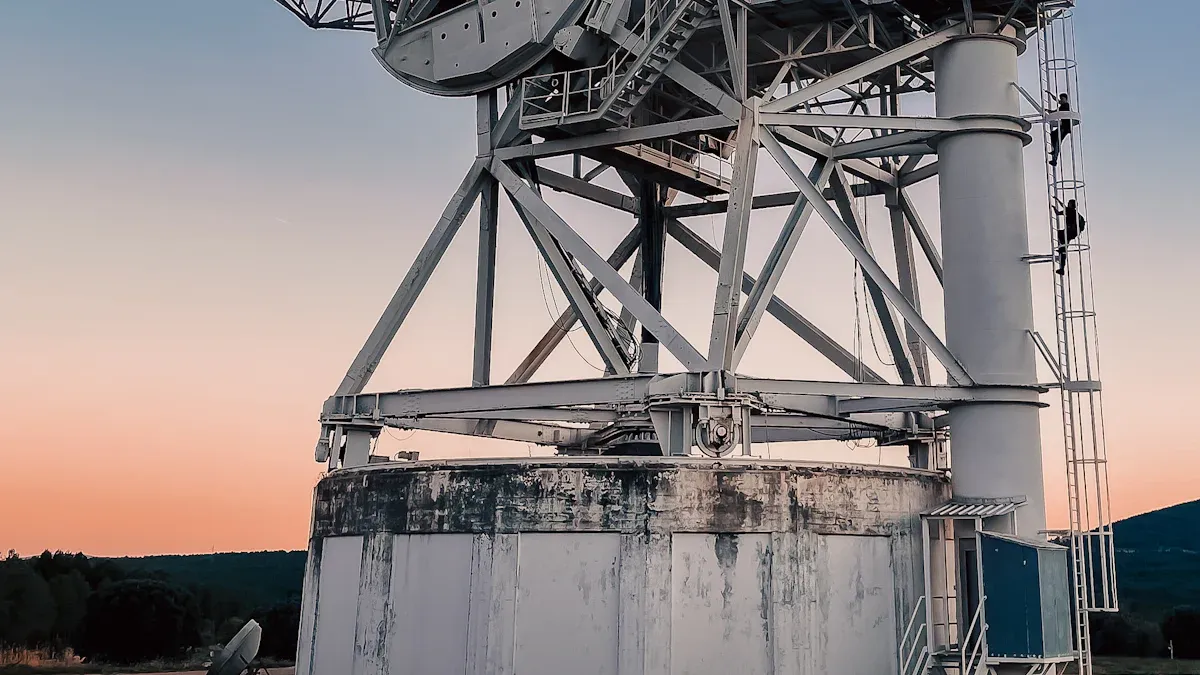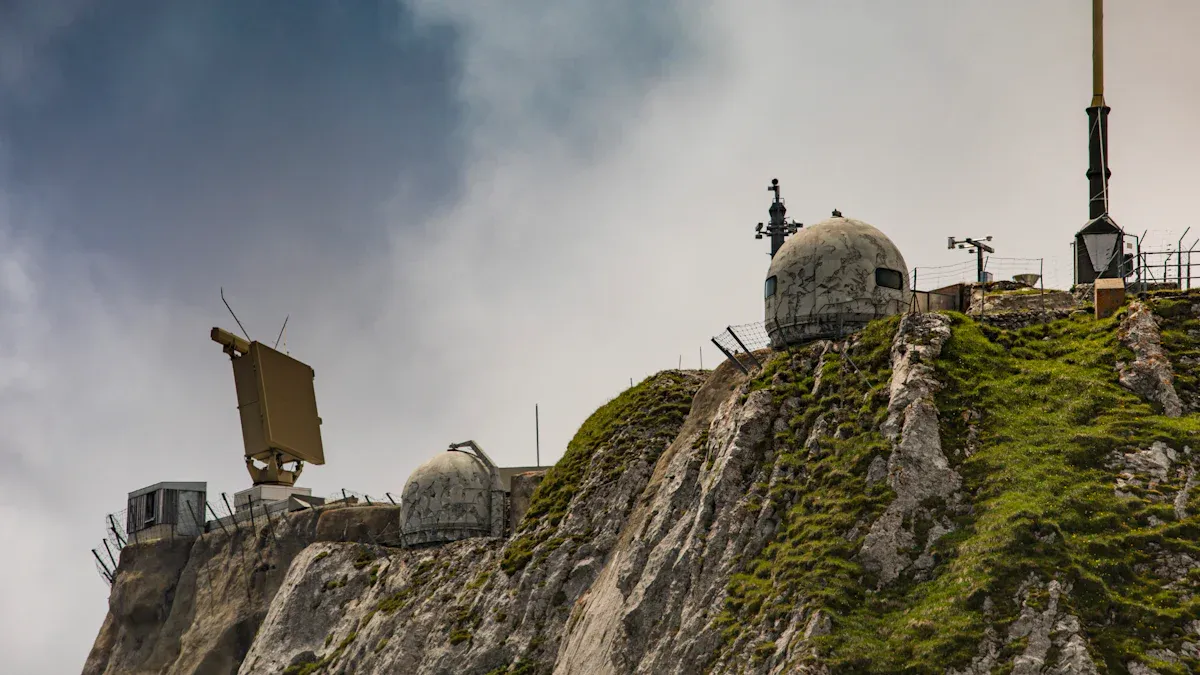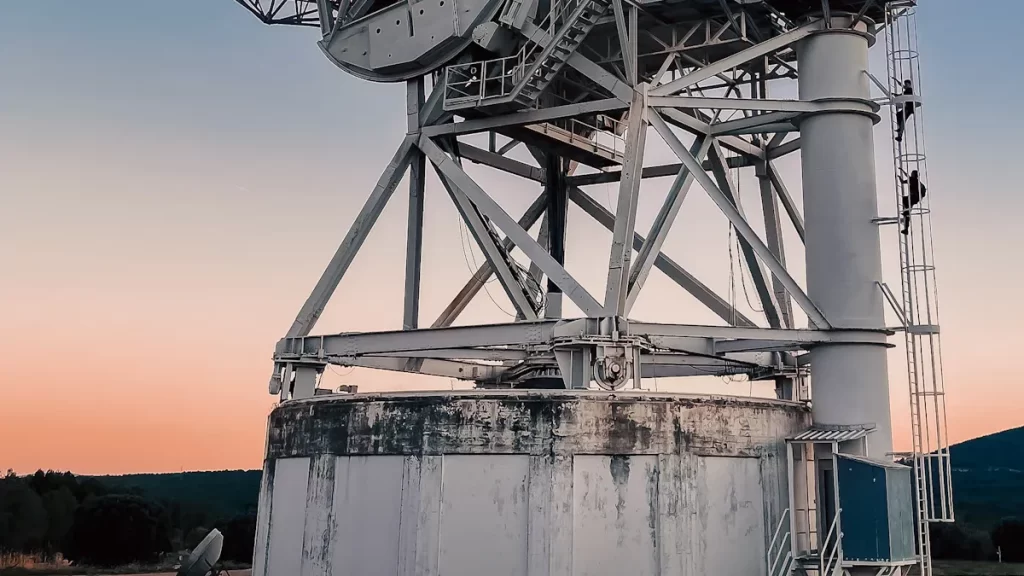
Choosing the right PCB materials is very important, especially for PCB weather radar for high-frequency signal processing. It helps radar systems work well at high frequencies. Think about how materials handle signals, heat, and stress. Bad choices can cause signal loss, overheating, or damage. For radar systems that process high-frequency signals, materials affect how reliable and accurate they are. Look at dielectric constant, thermal conductivity, and moisture resistance. This helps the radar work properly in tough conditions.
Key Takeaways
Pick PCB materials with low dielectric constant for faster signals in radar systems.
Use materials with low dissipation factor to keep signals clear and precise in fast circuits.
Focus on thermal conductivity to handle heat and avoid damage in strong radar systems.
Look for moisture-resistant materials to shield PCBs from tough weather and work reliably.
Combine different materials to save money and still design good radar systems.
Key Properties of PCB Materials for High-Frequency Radar Systems

When picking PCB materials for high-frequency radar, knowing their main features is important. These features affect how well your radar works and lasts. Below are the most important things to think about.
Dielectric Constant and Signal Speed
The dielectric constant (Dk) shows how fast signals move through a material. Lower Dk means signals travel faster and better, which is key for high-frequency uses. For radar, materials with steady and low Dk values reduce signal problems and improve performance.
For instance, laminates like Rogers RO4000 series have low Dk values. They are great for radar and 5G systems. These materials keep signals strong even at very high frequencies.
Tip: Always check the Dk of your PCB materials to match your radar’s frequency needs.
Dissipation Factor and Signal Quality
The dissipation factor (Df) measures how much energy turns into heat when signals pass through. A low Df keeps signals clear, especially in fast circuits. High Df materials can weaken signals, lowering radar accuracy and dependability.
PTFE materials, like Teflon, are great for low signal loss. But they are harder to make than other materials. If your radar needs high-frequency laminates with little signal loss, PTFE is a good choice despite the challenges.
Note: Choose materials with low Df values to keep your radar accurate and reliable.
Thermal Conductivity for Heat Control
Radar systems often get very hot because they use a lot of power. The thermal conductivity of PCB materials helps spread heat and protects parts from damage.
Different materials handle heat differently. Ceramic PCBs are great at spreading heat, with values up to 180 W/m·K. FR4 PCBs have much lower heat control, around 0.3–0.4 W/m·K. Metal core PCBs (MCPCBs) are in the middle, with heat control between 1 and 10 W/m·K based on the core.
Performance Metric | Ceramic Substrate PCB | FR4 PCB | Metal Core PCB (MCPCB) |
|---|---|---|---|
Thermal Conductivity | Very high (up to 180 W/m·K) | Low (0.3–0.4 W/m·K) | Moderate to high (1–10 W/m·K) |
Tip: For radar systems in hot conditions, pick materials with better heat control to keep them working well for a long time.
Coefficient of Thermal Expansion and Stability
The coefficient of thermal expansion (CTE) shows how much a material grows or shrinks with temperature changes. For radar systems, this is very important to keep the PCB strong. If the PCB material expands too much, it can harm solder joints and parts, causing them to break.
Pick materials with low and steady CTE for radar systems. Ceramic PCBs are great because they barely expand when heated. These materials keep the PCB steady even when temperatures change quickly, which often happens in radar use. FR-4 materials, however, expand more, making them less useful in very hot or cold places.
Tip: Match your PCB material’s CTE to your radar’s heat needs. This lowers stress and makes the system last longer.
Moisture Resistance for Environmental Durability
Radar systems often work in tough places like humid areas, rain, or near chemicals. Moisture resistance is key to keeping PCB materials working well. If water gets into the PCB, it can ruin its signal strength, damage parts, and cause rust.
To protect PCBs, industries use coatings or potting compounds. These create a shield against water, humidity, and dust. Ceramic PCBs are also great at resisting moisture, making them perfect for radars in harsh conditions.
Protection Method | Why Moisture Resistance Matters for PCBs |
|---|---|
Coatings or potting compounds | Block water, humidity, and chemicals, making PCBs last longer. |
Strong solder mask | Protects the board from water, dust, and chemicals, improving its lifespan. |
Choose PCB materials that resist moisture or add protective coatings. This helps your radar system work well even in hard environments.
Note: Moisture resistance doesn’t just protect the PCB; it also keeps radar signals clear and reliable.
Types of PCB Materials for High-Frequency Radar Systems
FR-4 and Its Limitations
FR-4 is a very common PCB material. It is cheap and easy to find, so many people use it. But it has problems when used in high-frequency radar systems. FR-4 has a high dielectric constant (Dk) and dissipation factor (Df). These can cause signal loss and poor performance at high frequencies. It also doesn’t handle heat well, which is bad for powerful radar systems.
FR-4 works fine for low-frequency or simple tasks. But for advanced radar systems with high frequencies, it doesn’t perform well. It can’t keep signals strong or stay stable in extreme conditions, making it less dependable.
Tip: Use FR-4 only if you need a low-cost option and don’t need high performance.
High-Frequency Laminates for Radar Applications
High-frequency laminates are made for radar system challenges. They have low Dk and Df, which means less signal loss and better signal flow. These materials also handle heat better than FR-4, making them great for powerful radar systems.
Popular choices include Rogers RO3000 and RO4000 series. These materials keep their electrical properties steady, even at high frequencies. They are also easier to work with than PTFE materials, which makes them a good choice for engineers.
Note: High-frequency laminates are a great mix of performance and ease of use, making them ideal for radar systems.
Ceramic-Based Substrates for Extreme Conditions
Ceramic-based substrates are perfect for tough environments. They handle heat well, expand very little, and resist moisture. These features make them great for radar systems in hot or wet places.
Common ceramic materials include aluminum nitride and alumina. They are very stable and last a long time. But they cost more and are harder to make than other materials.
Tip: Choose ceramic-based substrates for radar systems in extreme conditions where reliability is key.
Hybrid Materials for Cost-Performance Balance
Hybrid materials are a smart choice for saving money and keeping good performance in radar PCBs. They mix different materials to make the PCB work well without spending too much. For example, you can use high-quality materials like Rogers or Isola HF for important layers and cheaper FR-4 for other parts. This way, you keep signals strong and costs low.
One big advantage of hybrid materials is saving money while keeping key features. By using cheaper materials for less important layers, you can cut costs by up to 25%. At the same time, hybrid designs help control impedance, which is very important for radar systems with high frequencies.
Tip: Use high-frequency materials only where they are needed most. This saves materials and improves efficiency.
Hybrid materials also let you design the PCB stack to fit your radar’s needs. You can adjust the layers to match specific requirements. This makes hybrid materials a favorite for engineers who want both good performance and lower costs.
PTFE-Based Materials for Low-Loss Applications
PTFE-based materials, like Teflon, are great for radar systems needing clear signals. They have a very low dissipation factor, so they lose little energy when signals pass through. This makes them perfect for high-frequency systems where signal quality matters a lot.
PTFE materials also handle heat changes very well. They work great in places with changing temperatures, making them ideal for tough environments. But making PTFE materials can be tricky because of their special properties. Even so, their benefits often make them worth the effort for systems needing excellent signal clarity.
Note: PTFE materials work really well but can be expensive. Think about your system’s needs before choosing them.
When picking PTFE materials, make sure they match your radar’s frequency and environment. Choosing carefully will help your system work reliably and efficiently.
Choosing the Right PCB Material for Radar Systems
Matching Material Features to Radar Needs
Picking the right PCB materials means knowing what your radar needs. Different radar systems need specific materials to work their best. For example, aerospace radars need materials that handle high heat and moisture. Automotive radars need cheaper materials that keep signals clear during heat and shaking.
To match materials to your radar needs, focus on these:
Frequency Range: High-frequency radars need materials with low dielectric constant and dissipation factor to avoid signal loss.
Environmental Conditions: Materials with good heat control and moisture resistance work better in tough places.
Mechanical Stability: Materials with low thermal expansion last longer in changing temperatures.
Tip: Make a list of your radar’s working conditions. Match them with material features to make choosing easier.
Keeping Signals Strong in High-Frequency Radars
Strong signals are key for radars that work at high frequencies. Weak signals can cause wrong data and make the system less reliable. To keep signals strong, focus on picking the right materials and designing the PCB well.
Follow these tips to keep signals strong:
Pick materials with low signal loss to keep signals clear.
Use laminates with steady dielectric properties at all frequencies.
Design the PCB to avoid impedance mismatches.
Avoid sharp turns in signal paths to stop signal problems.
Note: Materials like PTFE laminates are great for high-frequency radars. They keep signals clear and lose little energy.
Handling Heat in Radar Systems
Radars create a lot of heat, especially in powerful systems. Managing heat is important to stop overheating and keep the system working well. PCB materials help spread heat and protect the system.
To handle heat problems:
Use materials with high heat control, like ceramic or metal core PCBs.
Add thermal vias and heat sinks to your PCB to spread heat better.
Use hybrid materials to save money while managing heat, mixing high-conductivity layers with FR-4 layers.
Material Type | Thermal Conductivity | Best Use Case |
|---|---|---|
Ceramic Substrates | Up to 180 W/m·K | Very hot environments |
Metal Core PCBs | 1–10 W/m·K | Medium heat situations |
Hybrid Materials | Varies | Budget-friendly heat management |
Tip: Check your radar’s heat performance often. Change your PCB design if needed to improve heat control.
Balancing Cost and Performance
Picking PCB materials for radar systems needs a balance. You want the radar to work well without spending too much money. To do this, you must check material features and how they affect performance.
Steps to Balance Cost and Performance:
Find Key Features: Focus on what your radar really needs. Look for things like low dielectric constant or good heat control. Don’t pay extra for features you don’t need.
Use Hybrid Designs: Mix expensive and cheaper materials. For example, use high-quality laminates for signal layers and FR-4 for less important layers.
Plan PCB Layout: Design the PCB to use fewer materials but still work well. Change layer thickness and placement to save money.
Think About Long-Term Costs: Cheap materials might cost less now but need more repairs later. Pick durable materials to avoid frequent replacements.
Tip: Look at the total cost over time, not just the starting price. Stronger materials can save money in the future.
Cost-Performance Comparison Table:
Material Type | Cost | Performance | Best Use Case |
|---|---|---|---|
FR-4 | Low | Not great for high-frequency | Low-frequency radar systems |
High-Frequency Laminates | Medium | Great for clear signals | Advanced radar systems |
Ceramic Substrates | High | Very strong and durable | Tough environments |
Hybrid Materials | Medium | Balanced | Budget-friendly radar systems |
By following these tips, you can choose materials that save money and work well for your radar system.
Ensuring Longevity in Harsh Operating Environments
Radar systems often face tough conditions like heat, humidity, and stress. To make them last longer, pick PCB materials that can handle these challenges without losing performance.
Key Factors for Longevity:
Heat Stability: Pick materials that don’t expand much with heat. Ceramic substrates are great for staying strong in high temperatures.
Moisture Protection: Choose materials that resist water and humidity. Adding coatings or potting compounds can make them even stronger.
Strength Against Stress: Use materials that can handle shaking and pressure. Hybrid designs mix flexibility and strength.
Rust Resistance: Pick materials that don’t rust or react to chemicals. This is important for radars near factories or oceans.
Note: Regular checks and tests can find problems early and help your radar last longer.
Longevity Enhancement Methods:
Protective Coatings: Cover the PCB to block water and dirt.
Heat Control: Add heat sinks and thermal vias to spread heat.
Strong Design: Use tough solder joints and connectors to handle stress.
Longevity Comparison Table:
Environmental Challenge | Recommended Material | Additional Measures |
|---|---|---|
Extreme Heat | Ceramic Substrates | Heat sinks, thermal vias |
High Humidity | PTFE-Based Materials | Protective coatings |
Mechanical Stress | Hybrid Materials | Strong solder joints |
Chemical Exposure | Rust-Resistant Laminates | Potting compounds |
By focusing on these points, your radar system can stay reliable and work well, even in hard conditions.
Emerging Trends in PCB Materials for High-Frequency Radar Systems

Eco-Friendly PCB Materials
The electronics world is focusing more on being green. PCB materials are now part of this change. For radar systems, eco-friendly choices are improving without losing quality. Makers are using halogen-free laminates to lower harmful chemicals while keeping them reliable. Scientists are also testing biodegradable materials made from plants. These new ideas aim to reduce harm to the planet during making and throwing away.
Safer solders are another big step forward. Lead-free solders and ones with fewer chemicals make work safer for factory workers and users. Ceramic materials with low dielectric constant (Dk <3.0) and dissipation factor (Df <0.002) are also being used. They work well for high-frequency systems and help the environment.
Trend | Description |
|---|---|
Halogen-free laminates | Lower harmful chemicals while staying reliable |
Biodegradable substrates | Plant-based materials being tested in labs |
Lead-free & low-chemical solders | Safer for workers and users |
High-frequency materials | Ceramic composites with Dk <3.0 / Df <0.002 |
Using these materials helps the planet and keeps radar systems working well.
Advanced Thermal Management Technologies
Radar systems need good heat control, especially at high frequencies. New ideas are helping spread heat better to keep systems safe. Thermal vias and heat spreaders are added to PCBs to move heat away from important parts. This stops overheating and makes electronics last longer.
Another cool idea is phase-change materials (PCMs). These materials soak up and release heat to keep temperatures steady. PCMs are great for small radar systems where there isn’t much space for cooling tools. Using these heat-control methods helps radar systems work better in tough places.
Innovations in Low-Loss Dielectric Materials
New dielectric materials are changing how radar systems handle signals. These materials lose less energy, keeping signals clear and accurate. Some new options include PTFE composites with better stability and ceramic-filled laminates with great electrical features.
Hybrid materials are also being made by mixing different types. For example, combining PTFE with ceramic fillers creates a strong and low-loss material. These new materials let engineers design radar systems that work well and last longer.
Tip: Pick dielectric materials that stay steady across different frequencies. This keeps radar signals clear and dependable.
3D Printing in PCB Manufacturing
3D printing is changing how PCBs are made for radar systems. This method lets you design and build PCBs with great accuracy and speed. Unlike older ways, 3D printing creates PCBs layer by layer, giving better design control.
One big benefit of 3D printing is making small and light PCBs. This is very helpful for radar systems in planes and cars, where size and weight matter a lot. It also allows combining many functions into one PCB, so fewer extra parts are needed.
Another advantage is trying out new materials. For instance, special inks and advanced plastics can make PCBs with unique features. This helps radar systems work better at high frequencies. Plus, 3D printing creates less waste, making it a greener choice for electronics.
Tip: Use 3D printing to quickly test your PCB designs. This helps improve your radar system before making it on a large scale.
Materials for Radar Systems Operating at 100 GHz
Radar systems working at 100 GHz need top-quality materials. At such high frequencies, even tiny signal losses can hurt accuracy. Materials with low dielectric constant and dissipation factor keep signals clear.
PTFE-based materials are often used because they lose very little signal. Ceramic-filled laminates are another good choice. They are strong, stable, and handle heat well, which is important for powerful radar systems.
Think about the environment where your radar will work. For example, in wet or harsh places, pick materials that resist moisture. Hybrid materials can also save money by mixing different types to meet your needs.
Note: Always test materials at the frequency your radar will use. This ensures they work well in real conditions.
Choosing the right PCB materials is very important for radar systems. These materials affect how well the system works and lasts. For instance, materials with very low dielectric constants (~2.1) are great for 5G devices. Materials with low signal loss work best for radar systems. Heat-resistant materials are perfect for satellites. Picking materials that match your radar’s needs gives the best results.
Learning about new trends like eco-friendly materials and better heat control helps you choose wisely. Check what your radar needs and pick materials that balance cost and performance. This way, your electronics will work well and last longer in 2025.
FAQ
What key features should PCB materials have for radar systems?
Focus on dielectric constant, dissipation factor, thermal conductivity, and moisture resistance. These features affect how well PCBs work in fast circuits and high-frequency uses.
Can FR-4 materials work for high-frequency radar systems?
FR-4 is not great for high-frequency radar. It has high dielectric constant and dissipation factor, causing signal problems. Use high-frequency laminates or ceramic-based materials for better results.
How do hybrid materials help in radar PCB designs?
Hybrid materials mix affordable and high-quality layers. This keeps costs low while improving performance. They also let you design PCBs to fit radar needs.
What are the new trends in PCB materials for radar systems?
New trends include eco-friendly materials, better heat control, and low-loss dielectric materials. These aim to boost performance and reduce harm to the environment.
Why is heat control important in radar PCBs?
Radar systems create a lot of heat when working. Good heat control stops overheating and keeps the system reliable. Materials like ceramic substrates spread heat well and protect the system.
See Also
Selecting An Aerospace PCB Supplier For Budget-Friendly Solutions
Designing PCBs That Withstand Vibration For Industrial Applications
Exploring High-Temperature PCB Materials For Industrial Applications





